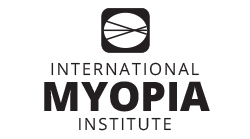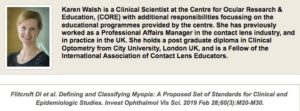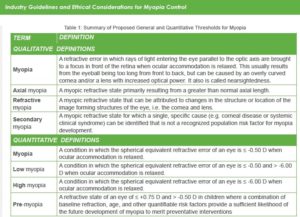

This summary of an International Myopia Institute (IMI) white paper was created by and is used with permission from the Centre for Ocular Research & Education (CORE) at the University of Waterloo’s School of Optometry & Vision Science in Waterloo, Ontario, Canada. It originally appeared in the April 2019 issue of Contact Lens Update, CORE’s free access online resource.

This committee was led by Ian Flitcroft. The group applied a consensus and evidence-based approach to develop standardised terminology, and to propose definitions of myopia, its thresholds and ocular complications.
When deciding on specific wording and threshold values, the committee considered several criteria to ensure final wording remained relevant to researchers, was appropriate for use in clinical research, helpful in describing the underlying biology of myopia and applicable to the development of public health policy.
It was recognised that historically a wide range of terms have been used to describe and categorise myopia. The report recommends consolidation of these definitions into the following categories: myopia, secondary myopia, axial myopia, and refractive myopia. Relevant for research purposes, a category of pre-myopia was also suggested, along with definitions of low and high myopia. These are summarised in Table 1 below, which has been adapted from the report:

Myopia, and especially higher degrees of myopia are associated with structural changes within the eye. These changes are sometimes termed ‘degenerative high myopia’. The committee proposes using ‘pathologic myopia’ instead.
Pathologic myopia is defined as: excessive axial elongation associated with myopia that leads to structural changes in the posterior segment of the eye (including posterior staphyloma, myopic maculopathy, and high myopia-associated optic neuropathy) that can lead to loss of best corrected visual acuity.
It was noted that inclusion of any value of refraction or axial length is unhelpful in this definition, because while pathologic myopia may be more commonly associated with high myopia, it is not exclusively so. The report also defines myopic macular degeneration, and a number of subdivisions of this pathology: myopic maculopathy, presumed myopia macular degeneration, myopic traction maculopathy and myopia-associated glaucoma-like optic neuropathy.
Overall, the report authors recognise the need for standardised definitions and use of consistent thresholds in the field of myopia management research and practice. Their hope is the proposed definitions are adopted, or at the very least, provide a starting point for wider discussion, derivation and development of a meaningful consensus.
Other CORE summaries of IMI white papers
CORE’s Contact Lens Update, a free online resource







